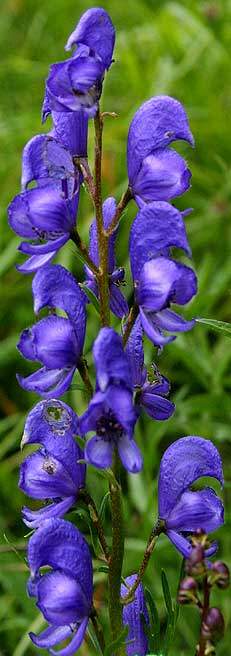
Common Names: Aconite, Aconito, Aconito Napello, Auld Wife's Huid, Blauer Eisenhut, Blue Rocket, Duivelskruid, European Monkshood, Friar's Cap, Kaplanbogan, Monk'Shood, Monk's-hood, Monkshood, Poison Aconite, Stormhat, True Monkshood, Tue Loup, Uva Verga, Venus' Chariot, Venus'-chariot, Yoshu-Tori-Kabuto, Habitat: Damp shady places and moist rich meadows in southern Wales and southwestern England.
Magickal Uses: *POISON* Don't ingest.
Gender: Feminine, Planet: Saturn, Sign: Capricorn, Element: Water, Deities: Hecate, Medea
Protection, Invisibility. Use this herb with great caution to consecrate the athame or ritual knife. Make an infusion with the leaves or root to banish prior energy from magickal blades and to infuse it with protection. The root or leaves may be burned as incense for the same purpose. Gather the fresh flowers to make a tincture to refresh the power of the knives. Use an infusion as a magickal wash for ritual tools or sacred space. Brings protection and magickal watchfulness against negative energies in ritual. Wash a new cauldron in the infusion or burn aconite in its first fire. Used to invoke Hecate. Wrap the seed in a lizard skin and carry to become invisible at will. Used to poison arrow tips in early times. Also as protection from and a cure for werewolves.
Edible Uses: HIGHLY TOXIC. Some reports suggest the root is edible if cooked, but these should be treated with extreme caution due to the highly toxic nature of the plant.
Medicinal Uses: Analgesic; Anodyne; Antirheumatic; Diaphoretic; Diuretic; Febrifuge; Homeopathy; Irritant; Sedative. Aconite has been used since ancient times, especially as an antidote to poisoning. Since the entire plant is itself very toxic, however, any use should be under the guidance of a skilled practitioner. All parts of the plant are used medicinally. The root is the most important and this is harvested as soon as the plant dies down in the autumn and is dried before use. The other parts of the plant are less important and are used fresh, being harvested when the plant is coming into flower. The root is analgesic, anodyne, antirheumatic, diaphoretic, diuretic, irritant and sedative. Due to its poisonous nature, it is not normally used internally though it has been used in the treatment of fevers. Externally, it is applied to unbroken skin in the treatment of rheumatism, painful bruises, neuralgia etc. All parts of the plant, except the root, are harvested when the plant is in flower and used to make a homeopathic medicine. This is analgesic and sedative and is used especially in the treatment of fevers, inflammation, bronchitis, neuralgia etc.
Cultivation: Thrives in most soils and in the light shade of trees. Grows well in heavy clay soils. Prefers a moist soil in sun or semi-shade. Plants only thrive in a sunny position if the soil remains moist throughout the growing season. Prefers a calcareous soil. Tolerates a pH in the range 4.5 to 7.5. Plants take 2 - 3 years to flower when grown from seed. Grows well in open woodlands. The flowers are very attractive to bees. Members of this genus seem to be immune to the predations of rabbits and deer. Although the plant is a perennial, individual roots only live for one year and die after flowering. Each root produces a number of 'daughter' roots before it dies and these can be used for propagating the plant. A greedy plant, inhibiting the growth of nearby species, especially legumes. An aggregate species which is divided by some botanists into many species.
Propagation: Seed - best sown as soon as it is ripe in a cold frame. The seed can be stratified and sown in spring but will then be slow to germinate. When large enough to handle, prick the seedlings out into individual pots and grow them on in a cold frame for their first winter. Plant them out in late spring or early summer. Division - best done in spring but it can also be done in autumn. Another report says that division is best carried out in the autumn or late winter because the plants come into growth very early in the year.
[Use] Extra care. Sow outdoors in fall for spring germination. The seed must be subjected to 2 or more weeks of warm, moist temperatures followed by 6 weeks or more of freezing temperatures. Expect germination as the ground warms up. Flowers in the second or third year to a height of four feet.
From the Mich. State Univ. Extension:
Hardiness Zone: 3 to 8
Height: 4 ft Spacing: 18 in
Type: herbaceous perennial
Flowers: Blue
Propagation: Propagation is by seed, or division done in autumn or early spring. Delay division until the plants absolutely need it. Starting seed may not be reliable. The seed needs moist storage at 41 degrees for six weeks to overcome dormancy.
Mode of poisoning: Ingestion.
Poisonous Part: All parts.
Symptoms: Burning of lips and mouth, numbness of throat; intense vomiting and diarrhea, muscular weakness and spasms, weak pulse, paralysis of the respiratory system, convulsions; may be fatal.
Toxic Principle:Alkaloids aconitine and others.
Description---The plant is a hardy perennial, with a fleshy, spindle-shaped root, palecoloured when young, but subsequently acquiring a dark brown skin. The stem is about 3 feet high, with dark green, glossy leaves, deeply divided in palmate manner and flowers in erect clusters of a dark blue colour. The shape of the flower is specially designed to attract and utilize bee visitors, especially the humble bee. The sepals are purple - purple being specially attractive to bees - and are fancifully shaped, one of them being in the form of a hood. The petals are only represented by the two very curious nectaries within the hood, somewhat in the form of a hammer; the stamens are numerous and lie depressed in a bunch at the mouth of the flower. They are pendulous at first, but rise in succession and place their anthers forward in such a way that a bee visiting the flower for nectar is dusted with the pollen, which he then carries to the next flower he visits and thereby fertilizes the undeveloped fruits, which are in a tuft in the centre of the stamens, each carpel containing a single seed.
In the Anglo-Saxon vocabularies it is called thung, which seems to have been a general name for any very poisonous plant. It was then called Aconite (the English form of its Greek and Latin name), later Wolf's Bane, the direct translation of the Greek Iycotonum, derived from the idea that arrows tipped with the juice, or baits anointed with it, would kill wolves - the species mentioned by Dioscorides seems to have been Aconitum lycotonum. In the Middle Ages it became Monkshood and Helmet-flower, from the curious shape of the upper sepal overtopping the rest of the flower. This was the ordinary name in Shakespeare's days.
The generic name is said to have been derived from , a dart, because it was used by barbarous races to poison their arrows, or from akone, cliffy or rocky, because the species grow in rocky glens. Theophrastus, like Pliny, derived the name from Aconae, the supposed place of its origin. The specific name, Napellus, signifies a little turnip, in allusion to the shape of the roots.
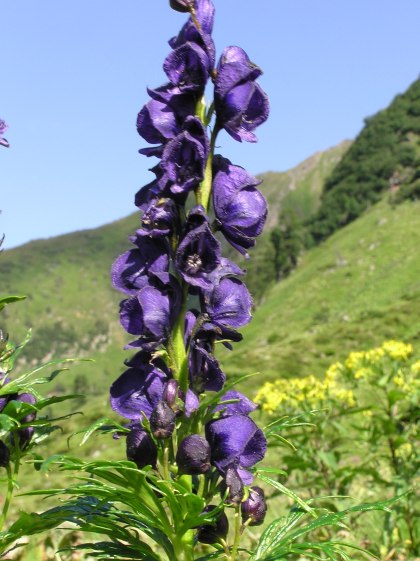
Reputed for its deadly charms, monkshood was formally administered to criminals. But the lethal alpine plant also holds invaluable healing qualities known to various cultures. In medieval Germany it was used in the concoction of Flugsalbe, a hallucinogenic flying potion. Caution: The whole plant is very poisonous and is particularly dangerous for children!Growing instructions
This plant is a cold-germinator. The sowing must be kept cold for a period of some weeks (refrigerator) or you sow them in very early spring or autumn. Mix the seeds with damp sand in a plastic bag. The sowing must be kept warm (about 20°C / 64 to 72°F and moist for the first 2-4 weeks. After this period place it in your refrigerator at a temperature of 5°C (between 25 and 39°F) for 5 to 6 weeks. After that take the bag out and keep it at room temperature. Check for sprouted seed regulary.
Cultivation---The chief collecting centres for foreign Aconite root have been the Swiss Alps, Salzburg, North Tyrol and Vorarlberg. Much was also formerly collected in Germany. Supplies from Spain and Japan are imported, so that the demand for English Aconite is somewhat restricted. The official Aconite is directed by the British Pharmacopceia to be derived only from plants cultivated in England, and a certain amount of home-grown Aconite has been regularly produced by the principal drug-farms, though good crops are grown with some difficulty in England, and cultivation of Aconite has not paid very well in recent years. Aconite prefers a soil slightly retentive of moisture, such as a moist loam, and flourishes best in shade. It would probably grow luxuriantly in a moist, open wood, and would yield returns with little further trouble than weeding, digging up and drying.
In preparing beds for growing Aconite, the soil should be well dug and pulverized by early winter frosts - the digging in of rotten leaves or stable manure is advantageous.
It can be raised from seed, sown 1/2 inch deep in a cold frame in March, or in a warm position outside in April, but great care must be exercised that the right kind is obtained, as there are many varieties of Aconite- about twenty-four have been distinguished - and they have not all the same active medicinal properties. It takes two or three years to flower from seed.
Propagation is usually by division of roots in the autumn. The underground portion of the plants are dug up after the stem has died down, and the smaller of the 'daughter' roots that have developed at the side of the old roots are selected for replanting in December or January to form new stock, the young roots being planted about a foot apart each way. The young shoots appear above ground in February. Although the plants are perennial, each distinct root lasts only one year, the plant being continued by 'daughter' roots.
This official Aconite is also the species generally cultivated in gardens, though nearly all the species are worth growing as ornamental garden flowers, the best perhaps being A. Napellus, both white and blue, A. paniculatum, A. Japonicum and A. autumnale. All grow well in shade and under trees. Gerard grew four species in his garden: A. lyocotonum, A. variegatum, A. Napellus and A. Pyrenaicum
This plant is a cold-germinator. The sowing must be kept cold for a period of some weeks (refrigerator) or you sow them in very early spring or autumn. Mix the seeds with damp sand in a plastic bag. The sowing must be kept warm (about 20°C / 64 to 72°F and moist for the first 2-4 weeks. After this period place it in your refrigerator at a temperature of 5°C (between 25 and 39°F) for 5 to 6 weeks. After that take the bag out and keep it at room temperature. Check for sprouted seed regulary.
Cultivation---The chief collecting centres for foreign Aconite root have been the Swiss Alps, Salzburg, North Tyrol and Vorarlberg. Much was also formerly collected in Germany. Supplies from Spain and Japan are imported, so that the demand for English Aconite is somewhat restricted. The official Aconite is directed by the British Pharmacopceia to be derived only from plants cultivated in England, and a certain amount of home-grown Aconite has been regularly produced by the principal drug-farms, though good crops are grown with some difficulty in England, and cultivation of Aconite has not paid very well in recent years. Aconite prefers a soil slightly retentive of moisture, such as a moist loam, and flourishes best in shade. It would probably grow luxuriantly in a moist, open wood, and would yield returns with little further trouble than weeding, digging up and drying.
In preparing beds for growing Aconite, the soil should be well dug and pulverized by early winter frosts - the digging in of rotten leaves or stable manure is advantageous.
It can be raised from seed, sown 1/2 inch deep in a cold frame in March, or in a warm position outside in April, but great care must be exercised that the right kind is obtained, as there are many varieties of Aconite- about twenty-four have been distinguished - and they have not all the same active medicinal properties. It takes two or three years to flower from seed.
Propagation is usually by division of roots in the autumn. The underground portion of the plants are dug up after the stem has died down, and the smaller of the 'daughter' roots that have developed at the side of the old roots are selected for replanting in December or January to form new stock, the young roots being planted about a foot apart each way. The young shoots appear above ground in February. Although the plants are perennial, each distinct root lasts only one year, the plant being continued by 'daughter' roots.
This official Aconite is also the species generally cultivated in gardens, though nearly all the species are worth growing as ornamental garden flowers, the best perhaps being A. Napellus, both white and blue, A. paniculatum, A. Japonicum and A. autumnale. All grow well in shade and under trees. Gerard grew four species in his garden: A. lyocotonum, A. variegatum, A. Napellus and A. Pyrenaicum
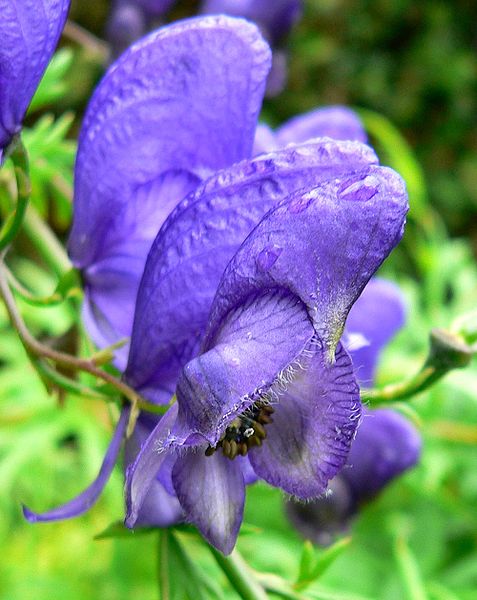
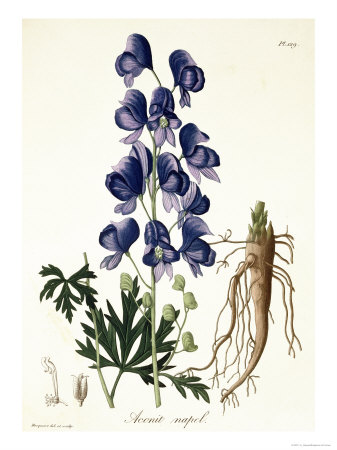
اقونیطون مأخوذ از یونانی داروئی مخدر و مسکن
که یک قسم آنرا باغبانهای تهران گل تاج الملوک گویندگیاه دایمی و افراشته که ریشه آن غده ای است. برگها سبز تیره، دارای تقسیمات عمیق، گلها به رنگ آبی تیره در فصل پاییز روی گل آذین های سنبله ظاهر می شوند. حداکثر بلندی ۱۵۰ و گستردگی آن به ۳۰ سانتیمتر می رسد.
جهت کاشت در ردیف پشتی حاشیه های گلکاری مناسب است.
نیازها: مکان آفتابی و یا سایه، خاک حاصلخیز که دارای زهکش خوب باشد. فاصله ۳۰ سانتیمتر برای کاشت بین دو بوته مناسب است. حداقل دمای قابل تحمل آن ۱۵- درجه سانتیگراد است.
ازدیاد: از طریق تقسیم گیاه هر دو یا سه سال یکبار در فصل پاییز پس از پایان گلدهی امکان پذیر است. هنگام تقسیم تنها غده های بزرگتر را جدا نموده و مجددا می کارند.
شرح گیاه
گیاهی است چند ساله علفی، پایا و به ارتفاع 50 تا 150 سانتی متر که به حالت خودرو در نقاط مرطوب و سایه دار نواحی کوهستانی تا ارتفاع 2500 متری می روید و امروزه به منظور استفاده های خاص یا زینتی پرورش داده می شود. آکونیت ریشه متورم ضخیم ، گوشتدار و ساقه ای پوشیده از برگهای بی کرک و به رنگ سبز تیره در سطح فوقانی پهنک دارد. پهنک برگ آن دارای بریدگیهای متعدد و عمیق است. گلهای درشت و زیبای آن به رنگ آبی گاهی ارغوانی یا سفید، نامنظم و مجتمع به صورت خوشه دراز است از مشخصات آقونیطون آنست که در ناحیه یقه یعنی قسمت بالای ریشه گیاه پس از ظاهر شدن ساقه بر دار، معمولاً یک یا دو جوانه جانبی پدید می آید. این جوانه ها پس از آنکه چند سانتی متر از یکدیگر فاصله پیدا کردند خمیدگی حاصل نموده در داخل خاک فرو می روند و بر اثر رشد و نمو تدریجی به ریشه ای متورم تبدیل می شوند به نحوی که در همان اواخر سال اول گیاه دارای 2 تا 3 غده متورم که یکی از آنها غده اصلی و مادر است می گردد پس از خاتمه گل دادن غده های کوچک مذکور در این زمان از نظر رنگ و حجم شباهت به تربچه های سیاه رنگ و کوچک دارند، که در سال بعد رشد و نمو کافی پیدا کرده و هر یک باعث پیدایش یک ساقه گلدار می شوند.
محل مناسب رویش
به حال خودرو در نقاط مرطوب و سایه دار نواحی کوهستانی تا ارتفاع 2500 متری و جهت پرورش آن زمینهای رسی سیلیسی سبک مناسب است.
روش کاشت
دانه های رسیده گیاه را معمولاً شهریور ماه در زمین آماده و اصلاح شده، در امتداد خطوطی با فاصله 20 سانتی متر در عمق خاک می کارند.
تکثیر بوسیله غده
تکثیر آقونیطون اگر به وسیله غده های جوان صورت گیرد باید در پائیز انجام شود این عمل متداولترین روش برای تکثیر گیاه می باشد و معمولاً بهتر از روش تکثیر آن به کمک دانه نتیجه می دهد. برای این کار غده ها را در زمین شخم زده و کود دار در امتداد خطوطی به فواصل 50 سانتی متری به نحوی می کارند که هر یک از دیگری حداقل 20 سانتی متر فاصله داشته باشد. با این روش حدود 100 هزار غده در هکتار کاشته می شود. دوران گل دهی خرداد تا شهریور
زمان برداشت
خرداد تا مهر که پس از در آوردن غده های (پیاز) از خاک و تمیز کردن باید آنها را به طور طولی بریده و سریعاً در درجه حرارت 40 تا 50 درجه سانتی گراد خشک نمود البته همانطور که ذکر شد عمل برداشت برگ و ریشه در زمان گل دادن گیاه انجام می گیرد و باید در موقع خارج کردن ریشه از خاک که به صورت غده های متورم در آمده اند انواع سنگین تر را انتخاب نمود. تذکر : از گیاهان سمی می باشد
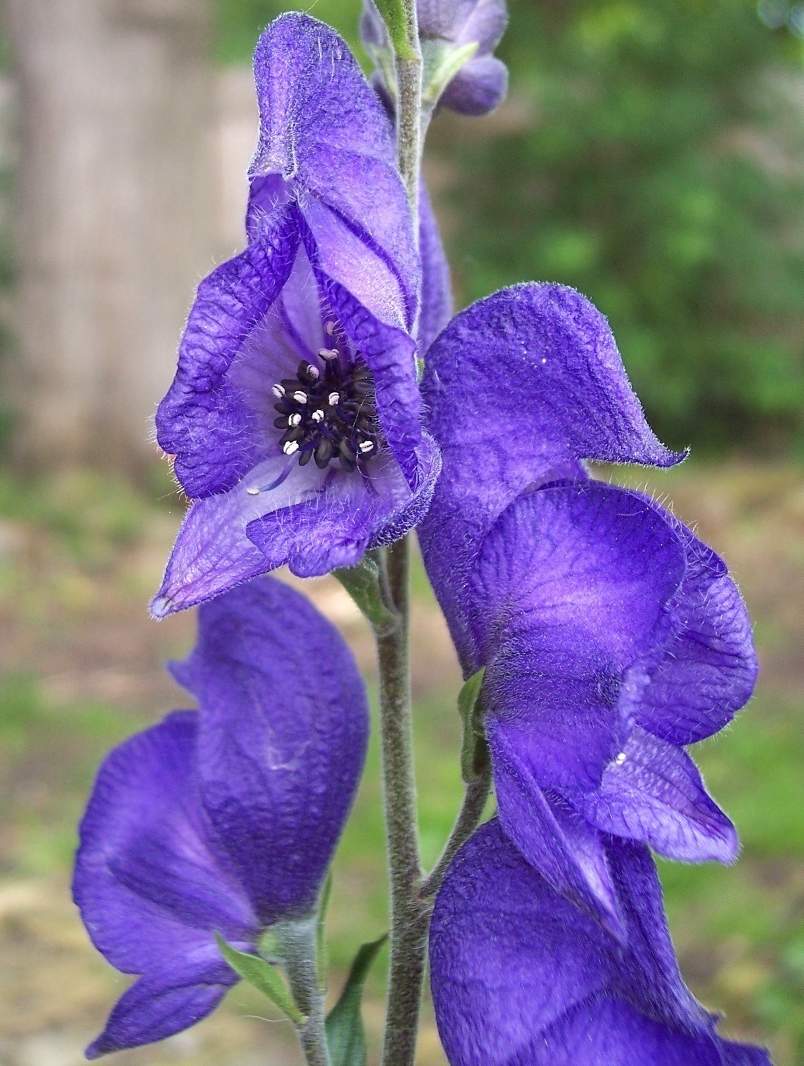 Medicinal Action and Uses---Anodyne, diuretic and diaphoretic. The value of Aconite as a medicine has been more fully realized in modern times, and it now rank as one of our most useful drugs. It is much used in homoeopathy. On account of its very poisonous nature, all medicines obtained from it come, however, under Table 1 of the poison schedule: Aconite is a deadly poison. Both tincture and liniment of Aconite are in general use, and Aconite is also used in ointment and sometimes given as hypodermic injection. Preparations of Aconitc are employed for outward application locally to the skin to diminish the pain of neuralgia, lumbago and rheumatism.
Medicinal Action and Uses---Anodyne, diuretic and diaphoretic. The value of Aconite as a medicine has been more fully realized in modern times, and it now rank as one of our most useful drugs. It is much used in homoeopathy. On account of its very poisonous nature, all medicines obtained from it come, however, under Table 1 of the poison schedule: Aconite is a deadly poison. Both tincture and liniment of Aconite are in general use, and Aconite is also used in ointment and sometimes given as hypodermic injection. Preparations of Aconitc are employed for outward application locally to the skin to diminish the pain of neuralgia, lumbago and rheumatism. The official tincture taken internelly diminishes the rate and force of the pulse in the early stages of fevers and slight local inflammations, such as feverish cold, larnyngitis, first stages of pneumonia and erysipelas; it relieves the pain of neuralgia, pleurisy and aneurism. In cardiac failure or to prevent same it has been used with success, in acute tonsilitis children have been well treated by a dose of 1 to 2 minims for a child 5 to 10 years old; the dose for adults is 2 to 5 minims, three times a day.
---Note---The tincture of Aconite of the British Pharmacopoeia 1914 is nearly double the strength of that in the old Pharmacopoeia of 1898.
Externally the linament as such or mixed with chloroform or belladonna liniment is useful in neuralgia or rheumatism.
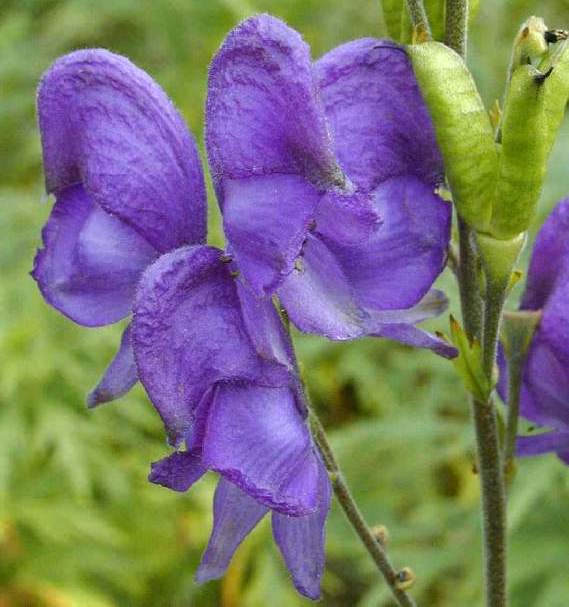 گیاه دایمی و افراشته كه ریشه آن غده ای است
گیاه دایمی و افراشته كه ریشه آن غده ای استبرگها سبز تیره، دارای تقسیمات عمیق، گلها به رنگ آبی تیره
در فصل پاییز روی گل آذین های سنبله ظاهر می شوند
حداكثر بلندی ۱۵۰ و گستردگی آن به ۳۰ سانتیمتر می رسد
جهت كاشت در ردیف پشتی حاشیه های گلكاری مناسب است
نیازها: مكان آفتابی و یا سایه، خاك حاصلخیز كه دارای زهكش خوب باشد
فاصله ۳۰ سانتیمتر برای كاشت بین دو بوته مناسب است
حداقل دمای قابل تحمل آن ۱۵- درجه سانتیگراد است
ازدیاد: از طریق تقسیم گیاه هر دو یا سه سال یكبار
در فصل پاییز پس از پایان گلدهی امكان پذیر است
هنگام تقسیم تنها غده های بزرگتر را جدا نموده و مجددا می كارند
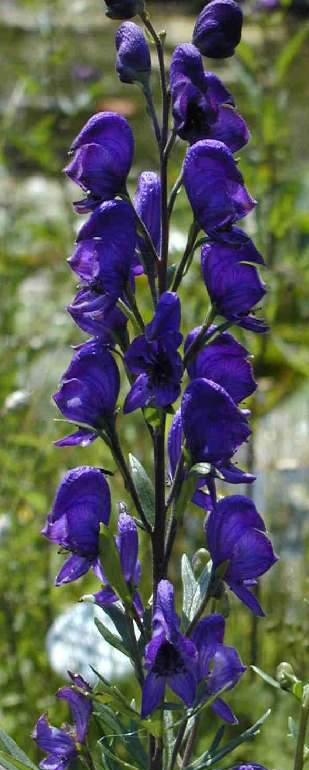
No comments:
Post a Comment